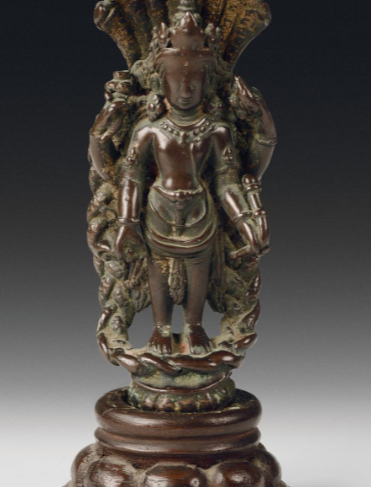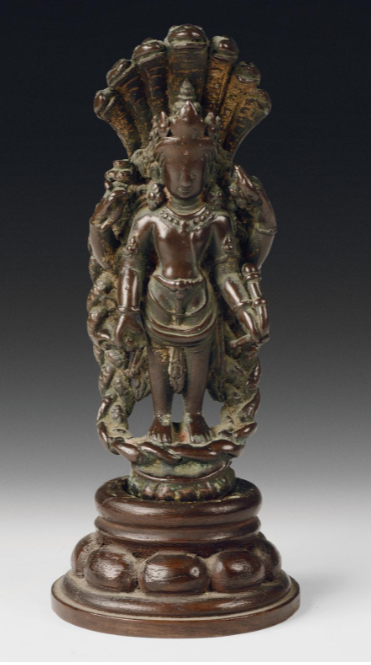Details
- Title : VISHNU
- Year : 16th or 17th Century
- Classification : Sculpture
- Medium : Gilt-bronze
- Dimension : Height 4 1/2 in. (11.5 cm.)
- Accession No : GNM_LOT 85_PUN_13
- Country/ Geo-location : Nepal
- Collection : PUNDOLE’S
- Status : LIVE AUCTION The Art of the Himalayas from the Collection of Roshan Sabavala (M0009) (As per NOV 2021)
- ESTIMATED : ₹100,000 - ₹150,000
- SOLD : ₹150,000
- NOTE : Vishnu stands in a frontal posture on the body of the serpent Ananta placed on a circular base, wearing a short dhoti with pleats and a longer tassle, a girdle tied at his waist. He is adorned with necklaces, heavy earrings, armlets and bracelets and holds the conch, the discus, the lotus and the mace in his four hands around him. His hair is tied back in a high top-knot surmounted by a lotus finial and secured with a five-leaf crown, curling tendrils falling around his ears. The serpent Ananta rises on both sides of the Deity to surround him entirely, his seven-headed hood sheltering Vishnu's head. The sculpture is based on the popular Indian depiction of Vishnu reclining on Anantashesha, the seven-headed serpent on whom Vishnu floats in the ocean of milk. Whilst this composition usually shows him reclining on the snake with his consort Lakshmi beside him, the Newari craftsmen have converted the composition into a standing arrangement. The serpent still protects Vishnu's head with his hood, and his thick body offers support and protection. For a similar bronze, see Dr. Pratapaditya Pal, Nepal: Where the Gods are Young, New York, 1975, p. 112, pl. 82. Dr. Pal terms this form Jalasayana Vishnu, an iconographic form that was especially popular in Nepal.

